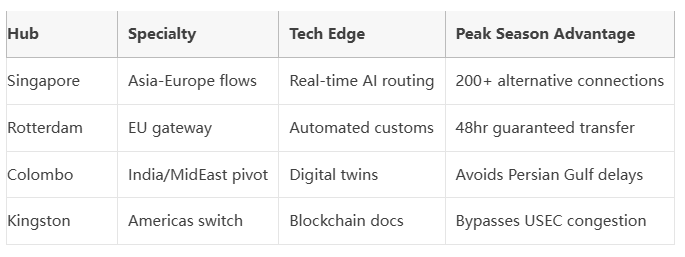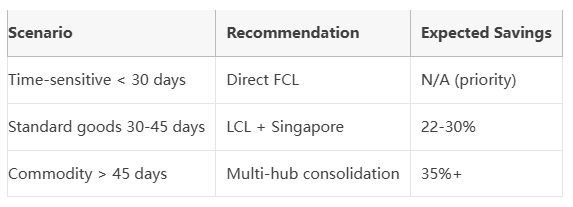LCL + Transit Hubs: Your Smart Combo to Avoid Peak Season Gridlock 2025
Peak season turns major ports into bottlenecks: Long Beach queues stretch 30+ days, Rotterdam handles 15,000 TEUs daily, and 25% of vessels miss berthing windows. Yet companies using LCL-transit hub combos report:
✅ 18-30% lower costs vs FCL
✅ 15-50% faster transit times
✅ 97% on-time delivery rates
Key Insight: Transit hubs like Singapore and Colombo act as "traffic controllers," rerouting cargo away from congested ports while LCL eliminates wasted container space.
How it works: Pool partial shipments with other shippers in shared containers.
Peak season advantages:
Cost control: Pay only for space used. Rotterdam LCL rates: $1.3/kg (min. 300kg)
Flexible scaling: Add shipments weekly without committing to full containers
Risk reduction: Diversify across multiple containers vs "all eggs in one FCL basket"
Real impact: A German machinery exporter cut costs 28% by combining shipments with Swedish furniture via Hamburg LCL consolidation.
Top 4 strategic hubs:

Step 1: Route Planning
Monitor congestion: Utilize platforms like Windward or Portcast
Hybrid routing: Pair primary hubs (Singapore) with secondary options (Port Klang)
Smart pairing: Match commodities with optimal hubs:
→ Electronics: Singapore (strict security)
→ Bulk commodities: Colombo (cost-focused)
Step 2: Operational Checklist
Pre-clear customs documentation
Install IoT trackers (e.g., Maersk Captain Peter)
Schedule buffer days (add 3-5 days for peak season)
Step 3: Cost-Priority Decision Matrix

1. Digital LCL Platforms
Platforms like Flexport LCL Dashboard provide:
Instant space booking
Co-shipper matching
Dynamic rerouting
2. Green Lane Partnerships
Major carriers now offer priority LCL services:
Maersk LCL Direct: Guaranteed 35-day Asia-Europe
MSC eLCL: Paperless hub transfers
3. Nearshoring Hubs
New transit options emerging:
Vietnam (Haiphong) for EU-bound textiles
Tanger Med for African e-commerce goods
The 60/40 Rule: Book 60% capacity early, keep 40% for last-minute LCL options
Documentation Hack: Use ICC's electronic FIATA documents to slash clearance time
Peak Season Calendar:
July-August → Pre-book Q4 holiday goods
October → Activate transit hub plans
November 15+ → Switch to premium LCL lanes
Your Move: Start small with one LCL-transit hub test shipment before peak season. Measure cost/time savings versus traditional routes. The data will speak for itself.
Q: How to prevent damage in shared containers?
A: Insist on:
Floor-loaded shipments (no stacking)
Professional bracing/strapping
Container condition reports with photos
Q: What's the real transit time via hubs?
Sample routes:
Shanghai → Singapore → Hamburg: 38-42 days
vs direct: 32-35 days (but 50% risk of 10+ day delays)
Q: Customs pitfalls with multi-origin LCL?
Solution: Use "consolidator as shipper" model - the hub agent becomes single DOC exporter
This approach transforms peak season from a survival test into a competitive advantage. The smartest shippers aren't fighting congestion - they're routing around it.